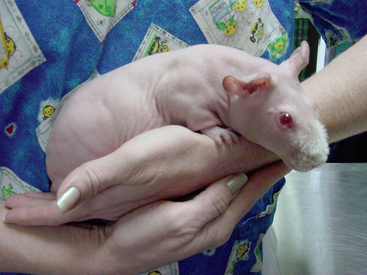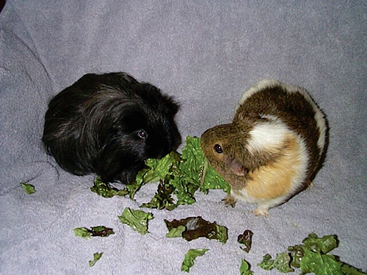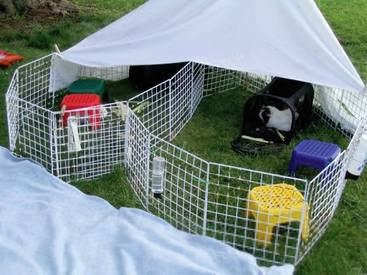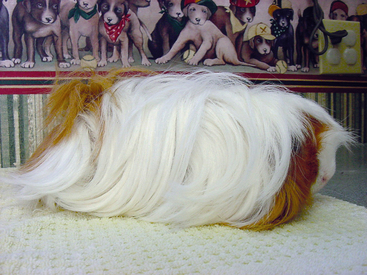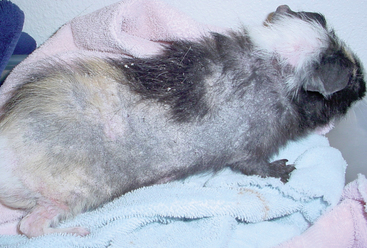CHAPTER 5 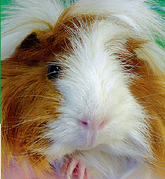 GUINEA PIG BEHAVIOR
GUINEA PIG BEHAVIOR
Natural History, Behavior, and Domestication
Exactly when guinea pigs (Cavia porcellus) were domesticated is still unknown, but it is suspected to have happened sometime between 500 and 1000 AD. Originally from South America, guinea pigs were used for food and for religious ceremonies by the Incas. They were first introduced into Europe approximately 400 years ago.37 In the wild they live in burrows or rock crevices in herds or in small groups of 5 to 1043 and exhibit a definitive social hierarchy with a dominant male and female. Wild cavies are crepuscular and feed at dawn and dusk.
As with other species the process of domestication in guinea pigs has led to changes in behavior such that the domestic guinea pig is less aggressive, exhibits increased social tolerance and increased male courtship behavior, and is less attentive to its surrounding environment than its wild counterparts.31 Guinea pigs have been used as animal models for autism in humans. The GS strain of guinea pigs, which are partially inbred, exhibit autism-like behavior patterns such as lack of response to and exploration of the environment, stereotypic motor behaviors, and poor social interaction because of cerebellar and corticocerebral abnormalities.5
Three original breeds were recognized: the American (or English), which has a smooth hair coat; the Abyssinian, which has a short, coarse coat with whorls or rosettes; and the Peruvian, which has long, silky hair. There are now thirteen breeds including several hairless varieties (Figure 5-1).
Social and Antisocial Behaviors
Guinea pigs are generally nonaggressive, docile animals, and with frequent, gentle handling and petting they are extremely responsive to attention and make affectionate pets. They readily and enthusiastically respond by whistling when greeting their human companions as well as to the sound of the crinkle of a produce bag or the opening of a refrigerator door. It is not uncommon for guinea pigs to lick human companions as a sign of affection and acceptance. Also, in stressful situations (in the examination room, for instance) a guinea pig will lick its owner as if seeking comfort and familiarity (Box 5-1).
BOX 5-1 Common Postures of Guinea Pigs
As an extremely social species, they live in the wild in small groups, seeking “safety in numbers,” because more eyes help alert them to the presence of predators. They can often be seen standing or lying side by side when resting and when eating.21 Bonding has been shown to be very important in domestic guinea pigs, and evidence of the effect of social support has been quantified by the detection of lower cortisol levels in both males and females placed in challenging situations when supported by a familiar guinea pig. Cortisol levels (as a measure of stress) are even lower when guinea pigs are challenged in the presence of a bonded mate.26
In a study of the effects of social stress in guinea pigs, unfamiliar males were paired and their behavior and physiological parameters measured over an 8-day period. Despite the fact that visual agonistic behaviors did not appear to increase during the duration of cohabitation, physiological parameters—including weight loss, lower testosterone levels, and higher glucocorticoid and plasma catecholamine titers—indicated that the stress levels increased for the less dominant males.41 The subordinate males behaved increasingly more passively until they finally ceased feeding and drinking.41
Despite the fact that guinea pigs are a precocial species that requires little maternal involvement after birth, social influences of the mother and other adults have been found to have a marked influence on behavior of the offspring.12 In a study of social preferences in young guinea pigs it was noted that both male and female pups stayed near the mother even through the postweaning period. Littermates continued to spend time together, and periadolescent animals reaching sexual maturity did not appear to associate more with novel animals or potential breeding partners.19 It is interesting to note, however, that male and female guinea pigs that were housed apart from the mother would then interact with her as if she were an unfamiliar female when reunited.14
Early social stress in guinea pig pups has been shown to create endocrine changes and changes in brain function, both of which are evidenced later by social behavioral changes. For example, several ontogenic studies have indicated that prenatal and immediate postnatal environmental and social factors affecting pregnant female guinea pigs can in turn affect how offspring will interact as adults. Stress of the mother during these periods may create a behavioral masculinity in the daughters (as evidenced by urine spraying).28,29 Also, more infantile behavior of the males in adulthood was noted. This was probably attributable to an increase in androgens in the stressed pregnant female as well as to the effect on the endocrine system in a stress response.25,27,29,40
Evidence of mother-infant attachment was demonstrated when increased cortisol levels were found in lactating guinea pigs (3 days postpartum) when their pups were removed and taken out of auditory range.15,18,39 Plasma cortisol levels also were elevated and vocalization was greater in the pups that were removed from the mother, more so in those placed alone than in those kept with their littermates.39 The presence of an adult female guinea pig, both familiar and unfamiliar, has also been shown to decrease the hypothalamic-pituitary-adrenal response in younger guinea pigs, even though behavioral interaction did not indicate this. The presence of an unfamiliar male did not evoke the same decrease in the stress response.14,16
All of this research would indicate that because of the extensive social nature of guinea pigs and their obvious need for support, in captivity they tend to do better in bonded pairs or trios rather than as solitary pets (Figure 5-2). Various reports in the lay literature suggest that bonding can be accomplished except with two intact males. Suggestions for the bonding process are outlined in the next section.
Taming and the Bonding Process
Guinea pigs are generally very gentle creatures that are not prone to scratching or biting unless provoked. Each has its own personality, however, and some will bite if an unwelcome procedure such as nail trimming is performed. Care must be taken with shy, not well-socialized cavies, as they are easily stressed and may injure themselves in attempts to escape.
Intraspecies aggression can occur with two males in the presence of females. It may also be seen between cavies that have not been raised together, especially between two unaltered males. Introducing a new pig should be done slowly and carefully and with direct adult supervision. The supervisors should be prepared to separate the guinea pigs if they begin to fight. This is best accomplished by wearing leather gloves or putting tennis shoes on the hands to protect them from being bitten. A plastic dustpan or a spray bottle of water may also be used.
Sensory Behaviors
Vocalization Behaviors
Many individuals, including owners, fanciers, and researchers, have characterized guinea pig vocalizations. The most common vocalizations include short impulse sounds such as the chip, purr, and chutter and the slow, modulated, relatively long call, the whistle.42 A list of common vocalizations as reported both in the lay literature and by researchers is included in this chapter (Box 5-2).
BOX 5-2 Common Vocalizations of Guinea Pigs*
* Additional information on guinea pig vocalizations can be found in Berryman JC: Guinea pig vocalizations: their structure, causation and function, Z Tierpsychol 41:80-106, 1976, and Harper LV: Behavior. In Wagner JE, Manning PJ, editors: The biology of the guinea pig, New York, 1976, Academic Press.
Locomotor Behaviors and Activities
A diurnal (crepuscular) species, cavies are most active in the early morning and the evening and, if not disturbed, will spend most of the day quietly resting with intermittent periods of activity and nibbling on food. In one study, guinea pigs in breeding groups were videotaped to determine their level of activity in a 24-hour period and were found to be active intermittently throughout both the day and night with “no prolonged period of quiescence that would be associated with sleep.”45
When at rest guinea pigs will lie on their sides with feet extended or they will remain sternal with their feet tucked under them. If presented with the opportunity they will often seek the shelter of a towel or hide box during resting periods. They often remain still with eyes open during midday sedentary periods and may startle and jump if disturbed.
Head tilt, paralysis, and paresis are seen less commonly in cavies than in lagomorphs (Figure 5-3). Rule-outs, however, are similar and include trauma, infection, neoplasia, and parasites. Trauma is perhaps the most common cause. Prevention of traumatic injury necessitates care in handling and direct supervision when not in a guinea pig–safe area or when the guinea pig is being handled by young children. Pododermatitis can occur, especially in obese cavies, when bedding is not kept clean and dry. Secondary infection with Staphylococcus aureus is common, and it will cause significant pain, vocalization, and reluctance to walk. Severe untreated infections can lead to osteomyelitis of the affected limbs.
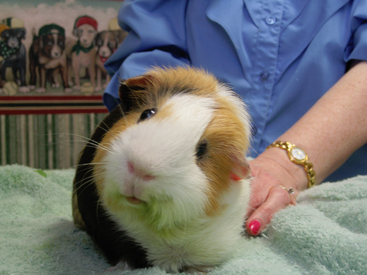
Figure 5-3 Guinea pigs can live well with a head tilt if managed carefully.
(Courtesy Teresa Bradley Bays.)
An increase in physical activity, as in humans and other species, may be chondroprotective, and the decrease in body mass that can be associated with increased exercise will also reduce the progression of osteoarthritis.4 Despite the fact that it has been shown that guinea pigs respond adversely to the stress associated with change, small changes in the cage space and enclosure furniture may encourage increased motility and exercise because of increased exploratory behavior (Figure 5-4).2
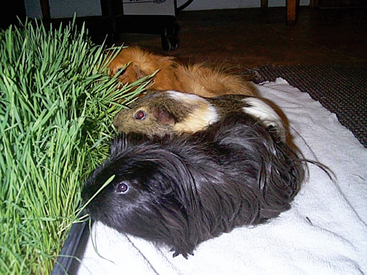
Figure 5-4 Grass can be organically grown for behavioral enrichment and to encourage exercise for guinea pigs.
(Courtesy Darice Heishman.)
Many owners create a guinea pig–safe area for their cavies to run in by eliminating the hazards of electric cords and dangerous items that can be eaten or chewed. Guinea pigs generally do not climb or jump, so it is not necessary to provide tops on enclosures, and small foldable portable fencing is available to create an exercise pen for cavies. Care must be taken, however, to eliminate any hazards that might be created by other household pets when these exercise pens are used. Alternatively, if these pens are used outside, it is imperative that an adult supervise the guinea pigs to eliminate the chance that they will escape or be molested or attacked by outside pets, strays, and wildlife (Figure 5-5).
Grooming Behaviors
All breeds of guinea pigs have longer guard hairs with an undercoat of finer hairs. Like most small mammal species, guinea pigs tend to be meticulous groomers. However, it is important to brush longhaired species regularly to minimize matting and ingestion of hair as it is shed (Figure 5-6). Since guinea pigs are unable to vomit, prevention of trichobezoar production is important. For this reason I do not recommend bathing guinea pigs, unless medically necessary, as the hair is shed readily after bathing. If bathing is needed, care must be taken to dry and brush the guinea pig well before self-grooming is allowed.
Generally, little mutual grooming occurs among guinea pigs; however, mutual or self-barbering and ear nibbling can occur when a guinea pig is bored, stressed (a possible dissociative behavior), or in a situation in which a dominant pig (usually a male) barbers subordinates.9,11 Self-barbering should be considered if only the head and neck, which cannot be reached, are unaffected. Self-barbering in rabbits has been found to be associated with low-fiber diets20,23,24 and may also have the same cause in guinea pigs.
Barbering can be distinguished from other causes of alopecia by the fact that the hairs will be chewed near the skin and feel bristly whereas the skin beneath appears to be healthy. Stressful environments that elicit barbering may be corrected by decreasing overcrowding and providing free-choice grass hays. Hide boxes and other distractions such as cardboard boxes and paper towel rolls will also help to curb these negative behaviors. Paper towel rolls should be cut in half lengthwise so smaller cavies do not get stuck in them.
Dermatophytosis and ectoparasites may also result in alopecia. Occasionally pathologic conditions of the skin such as a serious mite infestation can lead to severe seborrhea and a secondary overproduction of secretions from glands in the skin (Figure 5-7). Often these cavies will have rough hair coats, appear unkempt, and be too uncomfortable, in too much pain, and too pruritic to groom. They often squeal, panic, and run when touched. Pruritus may be so severe that the guinea pig will begin to seize as it scratches and can often be seen scratching again as it comes out of the seizure. In some cases, especially in overweight males, the penis can become surrounded and even constricted by a combination of these secretions and shed hair (Figure 5-8). Therefore, careful examination of the penis should be performed in all male guinea pigs during physical examination, especially if mites are suspected.
Stay updated, free articles. Join our Telegram channel

Full access? Get Clinical Tree


